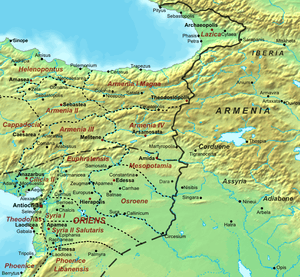Fifty-Year Peace Treaty

The Treaty of Dara, also known as the Fifty-Year Peace, was a peace treaty concluded between the Byzantine (Eastern Roman) and Sassanid (Iranian) empires at the frontier town of Dara in what is now southern Turkey in 562. The treaty, negotiated by Peter the Patrician for the Byzantine emperor Justinian I and Izadgushasp for the Sassanid king Khosrau I ended the 20-year-long war over the Caucasian kingdom of Lazica.[1]
The Sassanids undertook to evacuate Lazica, but the status of the neighboring country of Suania was left unclear to become a future source of disagreement. The Sassanids were to receive an annual subsidy of 30,000 gold nomismata, with the first seven years payable immediately. The Christians in Iran were promised freedom of religion. The peace treaty was to last for 50 years, but it remained in effect only until 572, when the two empires went into another war.[1]